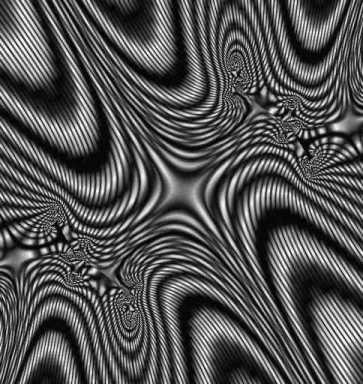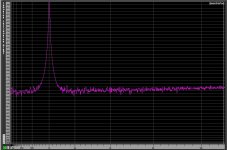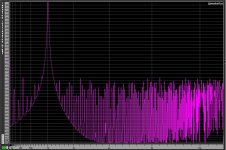Christophe,
It just seems if you can get the phase shift and group delay across the band correct everything starts to sound clearer. Perhaps this along with the instantaneous leading edge of the bass gives the impression of better bass. Obviously we are not increasing the air movement or anything else in the bass region by adding upper frequency response, perhaps it is the higher frequencies that let us tell a kick drum from a kettle drum. There is more to the sound of the drum head than just moving air or we would perceive all drums the same.
As far as engineers liking it here better than in France that may be just the tax rate that helps there? Besides we have great baguettes and cheese here now, food always helps!
It just seems if you can get the phase shift and group delay across the band correct everything starts to sound clearer. Perhaps this along with the instantaneous leading edge of the bass gives the impression of better bass. Obviously we are not increasing the air movement or anything else in the bass region by adding upper frequency response, perhaps it is the higher frequencies that let us tell a kick drum from a kettle drum. There is more to the sound of the drum head than just moving air or we would perceive all drums the same.
As far as engineers liking it here better than in France that may be just the tax rate that helps there? Besides we have great baguettes and cheese here now, food always helps!
Can somebody explain to me in plain English how dither, adding noise to a signal lowers the noise floor when reducing the bit rate?
Dither adds (a little) noise, but its use preserves information below the LSB level. Our critical band hearing then allows us to hear some of that preserved information, just as we would in the presence of the same (small) noise in other circumstances.
All good fortune,
Chris
Plain English will be the problem.Can somebody explain to me in plain English how dither, adding noise to a signal lowers the noise floor when reducing the bit rate?
Well, let's give a photographic example.You know this color banding you get on a digital captor using Bayer's matrix when there is in a landscape a repetitive pattern near the captors photo-sites spacing ? Adding an optical *noise* (AA filter) at those frequencies will blur the patern and prevent those artifacts.
Same thing for a signal when it is just at the limit of a bit: the Dither will bring-it sometimes to the upper one, sometimes to the lower. if it is the last one, you will keep something, instead of a brutal cut.
When you reduce the bits number, by dividing, you create an error (rounding). Noise will random this error in a more natural way.
Last edited:
Here's a link I post regularly when people who don't understand digital start pontificating. It's a clear and highly demonstrative look (and listen) at dither, and I am jealous that Werner did it and I didn't!
That Dither Thing - [English]
That Dither Thing - [English]
yep that was the example I was going to use, with offset and screen printing, you can with a half-tone screen, get what is called a Moire pattern when when the colour separations are out of alignment (error), or if you make a half-tone of a half-tone (for example by scanning and reprinting a printed page). we can think of this as our audio resolution in an imperfect system, some of these 'dots' will create interference patterns because they start out regular.
to combat this, high resolution inkjet and even high quality high end printing technique uses Stochastic screening, which is a sort of dithered imaging technique.
Moire

to combat this, high resolution inkjet and even high quality high end printing technique uses Stochastic screening, which is a sort of dithered imaging technique.
Moire

Last edited:
This one is funny too: it is a file with one white pixel, one black pixel. You can play with the zoom and see what happens:
Charte gris neutre
The original file is supposed to be just neutral grey.
Charte gris neutre
The original file is supposed to be just neutral grey.
Last edited:
Since we are so ot here let me ask a question. Can somebody explain to me in plain English how dither, adding noise to a signal lowers the noise floor when reducing the bit rate? I have read some of the information that George has presented and am having a time of understanding the principal here. A serious question as it seems so important to using some of the digital volume controls and other things in the digital world.
Noise floor I don't think is the right concept to understand dithering.
What in my conceptualization happens, is that with small signals, coded with only a few bits, the steps become quite large compared to the signal itself. Without dithering, these individual steps would become a subsignal on their own (they are correlated), creating audible distortion. With dithering, the individual steps become randomized because the noise introduces random variability in the trigger point of the ADC. So, the individual steps do no longer produce a correlated signal of their own. The only thing perceivable that survives is an approximation of the original signal, because the peaks and throughs of the original signal will remain.
Last edited:
Can somebody explain to me in plain English how dither, adding noise to a signal lowers the noise floor when reducing the bit rate?
If the noise floor of MANIPULATED, but undithered signal contains distortion components, these components indeed might be higher in amplitude than the same (manipulated) signal with added dither.
www.users.qwest.net/~volt42/cadenzarecording/DitherExplained.pdf
Note. I think Nika used Spectrafoo's Accumulation Mode setting "Pink noise is flat" in his measurements. This is why spectragraph plots look as if noise is rising towards high frequencies.
As Kindhornman pointed out, the transients are reproduced better. A high proportion of systems are hopeless at getting high impact musical intervals correct, and the vast majority of bass notes do have a decent high frequency, high initial energy envelope. Otherwise, all bass would sound like pipe organ notes ...As it it not supposed to be so, in common audiophile believes, i suppose that it is something really experienced. May-be it is amelioration of the acoustic slew rate during transients ?
If i had enough money, i would like to try, just to be sure that it is pure bul*sh*t.
May-be it is an acoustic phase question, as well, or a group delay one ? it would be interesting to explore.
Our brains know this,and reject bass lacking transients as poor bass. It is remarkable how one can get a subjective impression of very powerful bass on a very lowly system, with minimal power amps, when it manages the upper spectrum better than most ...
Frank
Kind, I'm not theorizing on this .. just reporting experimental fact .. and my tests were for 20kHz not 16kHz. The Golden Pinnae will ignore experimental results in their usual fashionJust goes to show you how opposing the theories are and what can be done. But I would sure like to know where the 24Khz and above material is supposed to be sourced from? Seems we have a quandary here, those who want upper end extension and those who profess that anything over 16Khz is just noise..... I'll stick with my thoughts that the experimenters have used devices that were just incapable of producing the upper frequencies without unwanted resonant breakup noise and distortion.
But you are perfectly right that there is a dearth of good material with >24kHz extension. We need this to investigate if the SOA has advanced enough to change the experimental results.
What would you use that is capable of producing upper frequencies without unwanted resonant breakup noise & distortion?
I've designed my share of such devices but they all rely on Unobtainium these days. My best effort was clean -3dB @ 30kHz with a Beryllium dome. There's loadsa stuff with similar or greater extension but huge compromises below 20kHz.
Last edited:
which is the one with the dither there?
See the file names
Last edited:
Thanks for this Stuart. It indeed demonstrates the advantages of dither.Here's a link I post regularly when people who don't understand digital start pontificating. It's a clear and highly demonstrative look (and listen) at dither, and I am jealous that Werner did it and I didn't!
That Dither Thing - [English]
But I'm suspicious of what he is using.
His "flat-spectrum Triangular Probability Distribution dither" sounds 'Pinkish' to me.
His "very aggressive noise-shaping" sounds more like (whitish) TPD dither. I expect properly noise shaped dither to have a spectrum more like Word Length Reduction | Benchmark Media and to sound Pinkish.
BTW, piano is VERY sensitive to the evil effects of undithered digital chains.
I first heard a demo of the evils of undithered digital in 1976 from Dr. Ray Steele at Loughborough U. The processing was done offline with a PDP11; at that time, the fastest computer on site.
Last edited:
Kgrlee,
As of this point my reference has been the TAD beryllium ET-703. Though I am not a fan of the diffraction lens they use the device is what I have come to use as a reference. I have Brush Wellman making some beryllium domes for me now and I should see them in the very near future. I am developing a new dome tweeter that I hope can get close to the sound of the TAD even though it will not be a compression driver like the TAD. That is the only device that I have heard that gets up that high without resonance below 24Khz. I imagine there may be some ribbon tweeters or perhaps a plasma device that may do similar but I haven't heard one yet. I'll use this device to go with my cone driver that I have already proven with working samples. This is a culmination of over 25 years of development work that I have been involved with. It would be easy if I was designing a compression driver, that would be the easy way out but I am working on something that is smaller than what I have done with waveguides.
As of this point my reference has been the TAD beryllium ET-703. Though I am not a fan of the diffraction lens they use the device is what I have come to use as a reference. I have Brush Wellman making some beryllium domes for me now and I should see them in the very near future. I am developing a new dome tweeter that I hope can get close to the sound of the TAD even though it will not be a compression driver like the TAD. That is the only device that I have heard that gets up that high without resonance below 24Khz. I imagine there may be some ribbon tweeters or perhaps a plasma device that may do similar but I haven't heard one yet. I'll use this device to go with my cone driver that I have already proven with working samples. This is a culmination of over 25 years of development work that I have been involved with. It would be easy if I was designing a compression driver, that would be the easy way out but I am working on something that is smaller than what I have done with waveguides.
Kindhornman, This sounds very close to what I did. I used a shallow waveguide. We got the dome from a Russia source.
If you have problems with too high a resonant peak at the first breakup, try a slightly thicker dome if you have sensitivity in hand. Compared to the Al, Ti and Ceramic domes we had used in the past, we were pleasantly surprised to find how easy it was to control the Be dome resonance by this simple measure.
The surround is also key and the plastic I used is now sadly Unobtainium too.
An example of a >30kHz device was the IonoFane but the horn it has to use severely compromised <20kHz stuff. I don't think you can get a ribbon type device to sensibly go up to 30kHz.
If you have problems with too high a resonant peak at the first breakup, try a slightly thicker dome if you have sensitivity in hand. Compared to the Al, Ti and Ceramic domes we had used in the past, we were pleasantly surprised to find how easy it was to control the Be dome resonance by this simple measure.
The surround is also key and the plastic I used is now sadly Unobtainium too.
An example of a >30kHz device was the IonoFane but the horn it has to use severely compromised <20kHz stuff. I don't think you can get a ribbon type device to sensibly go up to 30kHz.
Last edited:
- Status
- Not open for further replies.
- Home
- Member Areas
- The Lounge
- John Curl's Blowtorch preamplifier part II

